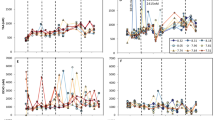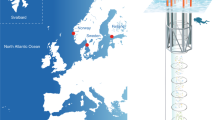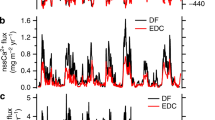Abstract
Marine microbiota are important for the global biogeochemical sulphur cycle, by making possible the transfer of reduced sulphur from the ocean to the atmosphere in the form of dimethyl sulphide1,2, DMS. Subsequent oxidation of DMS to acidic aerosols influences particle nucleation and growth over the oceans3, and so has the potential to influence radiative balance and global climate. It has been suggested4 that this plankton–climate interaction is self-regulated, but tests of this hypothesis have remained elusive as little is known about the feedback effects of climate on the marine DMS cycle2. DMS is produced by enzymatic cleavage of the abundant algal component dimethylsulphoniopropionate5 (DMSP), which suggests a high potential for DMS generation in the ocean. But there are competing processes6 that utilize DMSP in the food web without producing DMS, and the external controls on these processes are unknown. Here we present data of DMSP consumption, DMS production and mixing-layer depths (which are driven by climate) in the subpolar North Atlantic, and compare these data with published results from other latitudes. We find evidence that the mixing-layer depth has a substantial influence on DMS yield in the short term. This finding, combined with the seasonal effect of vertical mixing on plankton succession and food-web structure, suggests that climate-controlled mixing controls DMS production over vast regions of the ocean.
This is a preview of subscription content, access via your institution
Access options
Subscribe to this journal
Receive 51 print issues and online access
$199.00 per year
only $3.90 per issue
Buy this article
- Purchase on Springer Link
- Instant access to full article PDF
Prices may be subject to local taxes which are calculated during checkout


Similar content being viewed by others
References
Lovelock,J. E., Maggs,R. J. & Rasmussen,R. A. Atmospheric sulphur and the natural sulphur cycle. Nature 237, 452–453 (1972).
Andreae,M. O. & Crutzen,P. J. Atmospheric aerosols: Biogeochemical sources and role in atmospheric chemistry. Science 276, 1052–1058 (1997).
Clarke,A. D. et al. Particle nucleation in the tropical boundary layer and its coupling to marine sulfur sources. Science 282, 89–92 (1998).
Charlson,R. J., Lovelock,J. E., Andreae,M. O. & Warren,S. G. Oceanic phytoplankton, atmospheric sulphur, cloud albedo and climate. Nature 326, 655–661 (1987).
Malin,G. & Kirst,G. O. Algal production of dimethyl sulfide and its atmospheric role. J. Phycol. 33, 889–896 (1997).
Taylor,B. F. & Visscher,P. T. in Biological and Environmental Chemistry of DMSP and Related Sulfonium Compounds (eds Kiene, R. P., Visscher, P. T., Keller, M. D. & Kirst, G. O.) 265–276 (Plenum, New York, 1996).
Simó,R. & Pedrós-Alió,C. Short-term variability in the open ocean cycle of dimethylsulfide. Glob. Biogeochem. Cycles 13, 1173–1181 (1999).
Simó,R., Pedrós-Alió,C., Malin,G. & Grimalt,J. O. Biological cycling of DMS, DMSP and DMSP in contrasting marine waters. Limnol. Oceanogr. (submitted).
Kiene,R. P. Production of methane thiol from dimethylsulfoniopropionate in marine surface waters. Mar. Chem. 54, 69–83 (1996).
Bates,T. S. et al. The cycling of sulfur in surface seawater of the northeast Pacific. J. Geophys. Res. 99, 7835–7843 (1994).
Ledyard,K. M. & Dacey,J. W. H. Microbial cycling of DMSP and DMS in coastal and oligotrophic seawater. Limnol. Oceanogr. 41, 33–40 (1996).
Kiene,R. P., Visscher,P. T., Keller,M. D. & Kirst,G. O. (eds) Biological and Environmental Chemistry of DMSP and Related Sulfonium Compounds (Plenum, New York, 1996).
Stefels,J. & van Boekel,W. H. M. Production of DMS from dissolved DMSP in axenic cultures of the marine phytoplankton species Phaeocystis sp. Mar. Ecol. Prog. Ser. 97, 11–18 (1993).
Wolfe,G. V., Steinke,M. & Kirst,G. O. Grazing-activated chemical defence in a unicellular marine alga. Nature 387, 894–897 (1997).
Kiene,R. P., Linn,L. J., González,J., Moran,M. A. & Bruton,J. A. Dimethylsulfoniopropionate and methanethiol are important precursors of methionine and protein-sulfur in marine bacterioplankton. Appl. Environ. Microbiol. 65, 4549–4558 (1999).
Neale,P. J., Davis,R. F. & Cullen,J. J. Interactive effects of ozone depletion and vertical mixing on photosynthesis of Antarctic phytoplankton. Nature 392, 585–589 (1998).
Herndl,G. J., Müller-Niklas,G. & Frick,J. Major role of ultraviolet-B in controlling bacterioplankton growth in the surface layer of the ocean. Nature 361, 717–719 (1993).
Jeffrey,W. H. et al. Diel and depth profiles of DNA photodamage in bacterioplankton exposed to ambient solar ultraviolet radiation. Mar. Ecol. Prog. Ser. 137, 283–291 (1996).
van den Berg,A. J., Turner,S. M., van Duyl,F. C. & Ruardij,P. Model structure and analysis of dimethylsulphide (DMS) production in the North Sea, considering phytoplankton dimethylsulphoniopropionate- (DMSP) lyase and eutrophication effects. Mar. Ecol. Prog. Ser. 145, 233–244 (1996).
Margalef,R. Life-forms of phytoplankton as survival alternatives in an unstable environment. Oceanol. Acta 1, 493–509 (1978).
Kiørboe,T. Turbulence, phytoplankton cell size, and the structure of pelagic food webs. Adv. Mar. Biol. 29, 1–72 (1993).
Dacey,J. W. H., Howse,F. A., Michaels,A. F. & Wakeham,S. G. Temporal variability of dimethylsulfide and dimethylsulfoniopropionate in the Sargasso Sea. Deep-Sea Res. I 45, 2085–2104 (1998).
Bates,T. S., Cline,J. D., Gammon,R. H. & Kelly-Hanse,S. R. Regional and seasonal variations in the flux of oceanic dimethylsulfide to the atmosphere. J. Geophys. Res. 92, 2930–2938 (1987).
Nguyen,B. C., Mihalopoulos,N. & Belviso,S. Seasonal variation of atmospheric dimethylsulfide at Amsterdam Island in the southern Indian Ocean. J. Atmos. Chem. 11, 123–141 (1990).
Tarrasón,L., Turner,S. & Floisand,I. Estimation of seasonal dimethyl sulphide fluxes over the North Atlantic Ocean and their contribution to European pollution levels. J. Geophys. Res. 100, 11623–11639 (1995).
Kettle,A. J. et al. A global database of sea surface dimethylsulfide (DMS) measurements and a procedure to predict sea surface DMS as a function of latitude, longitude, and month. Glob. Biogeochem. Cycles 13, 399–444 (1999).
Brimblecombe,P. & Shooter,D. Photo-oxidation of dimethylsulfide in aqueous solution. Mar. Chem. 19, 343–353 (1986).
Siegel,D. A. & Michaels,D. F. Quantification of non-algal attenuation in the Sargasso Sea: implications for biogeochemistry and remote sensing. Deep-Sea Res. II 43, 321–345 (1996).
Bates,T. S., Charlson,R. J. & Gammon,R. H. Evidence for the climatic role of marine biogenic sulphur. Nature 329, 319–321 (1987).
Sarmiento,J. L., Hughes,T. M. C., Stouffer,R. J. & Manabe,S. Simulated response of the ocean carbon cycle to anthropogenic climate warming. Nature 393, 245–249 (1998).
Joos,F., Plattner,G.-K., Stocker,T. F., Marchal,O. & Schmitter,A. Global warming and marine carbon cycle feedbacks on future atmospheric CO2. Science 284, 464–467 (1999).
Karl,D. M. et al. Ecosystem changes in the North Pacific subtropical gyre attributed to the 1991-92 El Niño. Nature 373, 230–234 (1995).
Kiene,R. P. & Bates,T. S. Biological removal of dimethyl sulphide from sea water. Nature 345, 702–705 (1990).
Falkowski,P. G. & Raven,J. A. Aquatic Photosynthesis (Blackwell Science, Malden, 1997).
Woods,J. D., Barkmann,W. & Strass,V. in The Ocean Surface (eds Toba, Y. & Mitsuyasu, H.) 487–507 (Reidel, Dordrecht, 1985).
Acknowledgements
We thank all scientists, officers and crew aboard the RRS Discovery for assistance, P. Liss and T. Jinkells for leadership during fieldwork, W. Broadgate for setting up the cruise, P. Machine and G. Monocoiffé of the BODC for CTD and accessory data management, J. Grimalt for analytical facilities, and R. Kiene and K. Ledyard for providing accessory information to published data. R. Kiene also provided valuable comments. This work was supported by the Spanish CICyT through the Programa Nacional de Ciencia y Tecnología Marinas (CyTMAR) and the British NERC through the Atmospheric Chemistry Studies in the Oceanic Environment (ACSOE) Community Programme.
Author information
Authors and Affiliations
Corresponding author
Rights and permissions
About this article
Cite this article
Simó, R., Pedrós-Alió, C. Role of vertical mixing in controlling the oceanic production of dimethyl sulphide. Nature 402, 396–399 (1999). https://doi.org/10.1038/46516
Received:
Accepted:
Issue Date:
DOI: https://doi.org/10.1038/46516
This article is cited by
-
Oceanospirillales containing the DMSP lyase DddD are key utilisers of carbon from DMSP in coastal seawater
Microbiome (2022)
-
Vertical Chlorophyll and Dimethylsulfide Profile Simulations in Southern Greenland Sea
Journal of Ocean University of China (2022)
-
Extreme spikes in DMS flux double estimates of biogenic sulfur export from the Antarctic coastal zone to the atmosphere
Scientific Reports (2019)
-
Biogenic production of DMSP and its degradation to DMS—their roles in the global sulfur cycle
Science China Life Sciences (2019)
-
The quantitative role of microzooplankton grazing in dimethylsulfide (DMS) production in the NW Mediterranean
Biogeochemistry (2018)
Comments
By submitting a comment you agree to abide by our Terms and Community Guidelines. If you find something abusive or that does not comply with our terms or guidelines please flag it as inappropriate.



